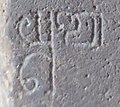Yūpa
AYūpa(यूप), orYūpastambha,was aVedicsacrificial pillar used inAncient India.[1]It is one of the most important elements of theVedic ritualsforanimal sacrifice.[2]
The execution of a victim (generally an animal), who was tied at the yūpa, was meant to bring prosperity to everyone.[1][2]
Most yūpa, and all from the Vedic period, were in wood, and have not survived. The few stone survivals seem to be a later type of memorial using the form of the wooden originals. The Isapur Yupa, the most complete, replicates in stone the rope used to tether the animal. The topmost section is missing; texts describe a "wheel-like headpiece made of perishable material", representing the sun, but the appearance of that is rather unclear from theGupta periodcoins that are the best other visual evidence.[3]
Isapur Yūpa
[edit]The Isapur Yūpa, now in theMathura Museum,was found at Isapur (27°30′41″N77°41′21″E/ 27.5115°N 77.6893°E) in the vicinity ofMathura,and has an inscription in the name of the third century CEKushanrulerVāsishka,and mentions the erection of the Yūpa pillar for a sacrificial session.[4][5]
-
Vāsishkainscription on the Isapur Yūpa.
-
Translation of the inscription mentioning the usage of the sacrificial pillar.
-
Isapur Yūpa with sculpture of a rope and noose to be tied to the sacrificial animal.[6]
Yūpa in coinage
[edit]During theGupta Empireperiod, theAshvamedhascene of a horse tied to a yūpa sacrificial post appears on the coinage ofSamudragupta.On the reverse, the queen is holding achowriefor the fanning of the horse and a needle-like pointed instrument, with legend "One powerful enough to perform the Ashvamedha sacrifice".[7][8]
-
Samudraguptacoin with horse standing in front of a yūpa sacrificial post, with legend "The King of Kings, who had performed the Ashvamedha sacrifice, wins heaven after conquering the earth".[7][8]
-
Another version of the Ashvamedha scene. Coinage of Samudragutpa.
Yūpa inscription in Indonesia
[edit]The oldest known Sanskrit inscriptions in theNusantaraare those on seven stone pillars, orYūpa( "sacrificial posts" ), found in the eastern part ofBorneo,in the historical area ofKutai,East Kalimantanprovince.[9]They were written byBrahminsusing the earlyPallava script,in theSanskritlanguage, to commemorate sacrifices held by a generous mighty king calledMulavarmanwho ruled theKutai Martadipura Kingdom,the first Hindu kingdom in presentIndonesia.Based on palaeographical grounds, they have been dated to the second half of the 4th century CE. They attest to the emergence of anIndianized statein the Indonesian archipelago prior to 400 CE.[10]
In addition toMulavarman,the reigning king, the inscriptions mention the names of his fatherAswawarmanand his grandfatherKudungga(the founder of the Kutai Martadipura Kingdom). Aswawarman is the first of the line to bear aSanskritname in the Yupa which indicates that he was probably the first to adhere to Hinduism.[10]
-
Mulavarman inscription on a yūpa, 5th century CE
-
Mulavarman inscription on a yūpa, 5th century CE
-
The word "Yūpo"in Brahmi in a Mulavarman Inscription, Muara Kaman, Kalimantan, 5th century CE
Text
[edit]The four Yupa inscriptions founded are classified as "Muarakaman" s and has been translated by language experts as follows:
|
Muarakaman I[11]
|
Muarakaman II[12]
|
Muarakaman III[12]
|
Muarakaman IV[13]
|
Translation
[edit]Translation according to theIndonesia University of Education:[14]
|
Muarakaman I |
Muarakaman II |
Muarakaman III |
Muarakaman IV |
The Yupas are now kept in theNational Museum of IndonesiainJakarta.
References
[edit]- ^abBonnefoy, Yves (1993).Asian Mythologies.University of Chicago Press. pp. 37–39.ISBN978-0-226-06456-7.
- ^abSAHOO, P. C. (1994). "On the Yṻpa in the Brāhmaṇa Texts".Bulletin of the Deccan College Research Institute.54/55: 175–183.ISSN0045-9801.JSTOR42930469.
- ^Irwin, John, "The Heliodorus Pillar: A Fresh Appraisal", p. 8, AARP,Art and Archaeology Research Papers,December, 1974,Internet archive,(also published inPurātattva,8, 1975-1976, pp. 166-178)
- ^Catalogue Of The Archaeological Museum At Mathura.1910. p. 189.
- ^Rosenfield, John M. (1967).The Dynastic Arts of the Kushans.University of California Press. p. 57.
- ^Singh, Upinder (2008).A History of Ancient and Early Medieval India: From the Stone Age to the 12th Century.Pearson Education India. pp. 431–433.ISBN978-81-317-1677-9.
- ^abcHouben, Jan E. M.; Kooij, Karel Rijk van (1999).Violence Denied: Violence, Non-Violence and the Rationalization of Violence in South Asian Cultural History.BRILL. p. 128.ISBN978-90-04-11344-2.
- ^abcGanguly, Dilip Kumar (1984).History and Historians in Ancient India.Abhinav Publications. p.152.ISBN978-0-391-03250-7.
- ^Kulke, Hermann (1998).A History of India.p. 145.
- ^abS. Supomo, "Chapter 15. Indic Transformation: The Sanskritization ofJawaand the Javanization of theBharata"in Peter S. Bellwood, James J. Fox,Darrell T. Tryon(eds.),The Austronesians: Historical and Comparative Perspectives,Australian National University, 1995
- ^R.M. Poerbatjaraka,Riwayat Indonesia,I, 1952, hal. 9.
- ^abR. M. Poerbatjaraka, Ibid., hal. 10.
- ^R. M. Poerbatjaraka, Ibid., hal. 11.
- ^Sumantri, Yeni Kurniawati. Rangkuman Materi Perkuliahan:Sejarah Indonesia Kuno.Fakultas Pendidikan Ilmu Pengetahuan Sosial, Universitas Pendidikan Indonesia.
- ^Note: archaeologists and historical experts has stated that "Waprakeswara" referred to a field dedicated to worship the Lord Shiva





![Isapur Yūpa with sculpture of a rope and noose to be tied to the sacrificial animal.[6]](https://upload.wikimedia.org/wikipedia/commons/thumb/e/e0/Isapur_Yupa_with_sculpture_of_a_rope_and_noose_to_be_tied_to_the_sacrificial_animal.jpg/69px-Isapur_Yupa_with_sculpture_of_a_rope_and_noose_to_be_tied_to_the_sacrificial_animal.jpg)
![Samudragupta coin with horse standing in front of a yūpa sacrificial post, with legend "The King of Kings, who had performed the Ashvamedha sacrifice, wins heaven after conquering the earth".[7][8]](https://upload.wikimedia.org/wikipedia/commons/thumb/a/ac/Dinar_of_Samudragupta_LACMA_M.84.110.1_%281_of_2%29.jpg/100px-Dinar_of_Samudragupta_LACMA_M.84.110.1_%281_of_2%29.jpg)
![The queen, reverse of last, is holding a chowrie for the fanning of the horse and a needle-like pointed instrument, with legend "One powerful enough to perform the Ashvamedha sacrifice".[7][8]](https://upload.wikimedia.org/wikipedia/commons/thumb/b/b1/Dinar_of_Samudragupta_LACMA_M.84.110.1_%282_of_2%29.jpg/100px-Dinar_of_Samudragupta_LACMA_M.84.110.1_%282_of_2%29.jpg)




